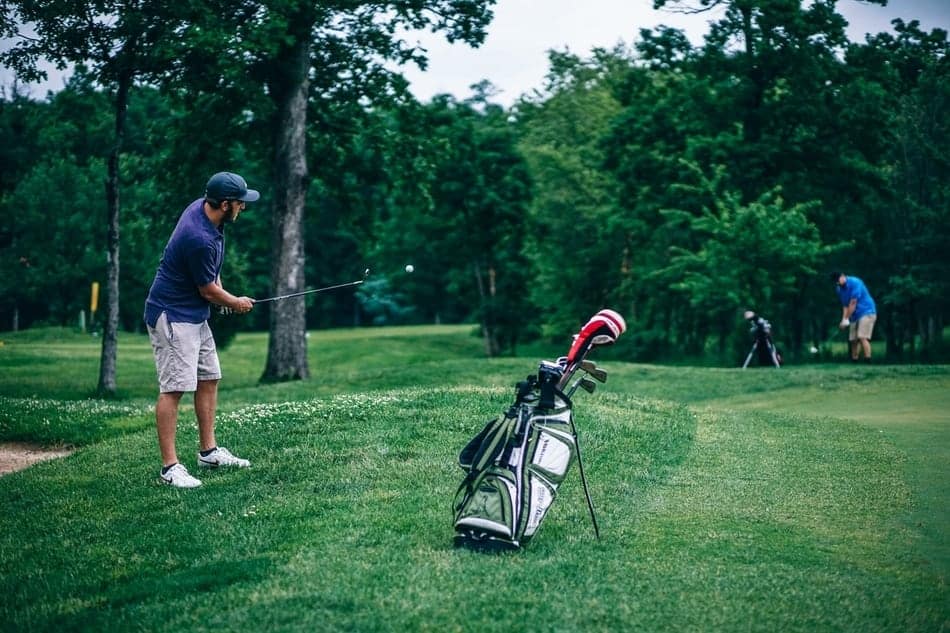
Try finding a lower handicap golfer that isn’t a good chipper of the golf ball. You won’t find anyone because most low handicap players are great at chipping, especially with a lob wedge.
If you are chipping with a lob wedge, you are probably in a tough situation. The whole point of chipping is to get the ball on the green as quickly as possible so the ball starts rolling sooner.
If you don’t have the right tools to get the job done, you will never find success.
The Wilson Harmonized golf wedge is hands down one of the best wedges for the best price on Amazon.
I highly encourage you to check it out and read some of the reviews people are writing about this club.
Moving On
In the video below, it shows a perfect example of getting the all to land softly and soon so it can roll.
I find it interesting when I see mid to higher handicappers that spend so little time on improving their short game.
Check out the video below and the rest of the post to get more tips and tricks.
Think About It
By definition, higher handicap golfers are not going to hit the greens as often.
They are going to leave themselves with chip shots much more often. So why not spend some time getting better at chipping and immediately start taking strokes off your game?
I can tell you unequivocally, that if you are a higher handicap golfer you need to spend more time in this area.
Spending some time to improve your chipping skills will save you at least one to two strokes per hole.
Now that’s some serious scoring… wouldn’t you agree?
Not a whole lot of people know about this one page on amazon. You can get anywhere from 10% off to 50% off on certain items.
Gain Some Confidence
Much of chipping around the green is confidence and with practice your confidence will improve along with your chipping so it has a snowballing effect.
Let’s take a look at a few elements of chipping that will get you going in the right direction and on you way to lowering your golf score.
First of all, select the right tool for the job. One problem or mindset that many golfers have is that; if I’m around the green and am going to chip.
You use your pitching or sand wedge. If this is you, I want you to learn to select the proper club for the shot that is required.
Actually let me back up slightly, first, evaluate the shot and where you want the ball to land.
Are you hitting the ball over sand, a large patch of grass, a sidewalk? Identify your hazards.
Then get the club out that is going to do the best job for that particular lie and the amount of room you have on the green.
Should You Use A Lob Wedge?
Just because you’re close to the green doesn’t mean you need to use your lob wedge every time.
What if you had plenty of green to work with and the pin was uphill? You wouldn’t want to land the ball on the green right away with a lob wedge and let it roll the rest of the way.
This would surely fall short of the pin but if you chose to hip a less lofted club, like a pitching wedge or even a 9 iron, this would work better.
What About This
If you were chipping down hill and you only had 20 feet between you and the hole.
You are just off the fringe and in the rough. This would be a perfect lie to use your lob wedge.
If you could land the ball as soon as possible and let the slope of the green take the ball the rest of the way.
Not Sure Which Club?
If you’re not sure about what club imparts what type of behavior on the golf ball, just try different clubs and shots around the practice green.
Work to get comfortable with several different clubs and approaches to your chipping.
The physical aspects of chipping are very straight forward.
You want to keep your hands slightly ahead of the clubhead. Both in your set up and as your hands and club pass through the impact zone.
Press your weight slightly forward during your set up and keep your weight pressed slightly forward throughout your chipping motion.
Use a one-piece take-a-way and motion. This is a biggie with higher handicappers… they tend to get ‘flippy’ with their hands.
When this happens the tendency is for the club head to begin to accelerate past the hands (a bad thing).
This results in the club either ‘chunks’ behind the ball or you hit the dreaded blade shot clear across the green.
Never Do This
Never decelerate the club as you come into the hitting zone. Confidence plays a big part in this for people who aren’t good chippers.
In order to get yourself to consistently accelerate through the shot, you need to practice, a lot.
when you are practicing, initially don’t worry so much about a precise target and if you are going to fly the ball too far.
Just work on a smooth chipping motion making good contact each and every time. We’ll work on distance control once you master the motion.
No Time To Practice?
Don’t let this excuse keep you from getting better! There are plenty of ways to practice your chipping that doesn’t require you to go to the course or driving range.
For instance, what if you just practice the motion in your living on the carpet.
If you have a backyard you could hit plastic golf balls or even real golf balls (just don’t let them get away from you).
You could also use Almost Golf Balls, I purchased these a while back and have lost most of them.
But these are perfect for doing small chipping around the house and backyard
Hopefully everything in this post makes sense! The most important thing to take away is club selection and practice.
This generally comes with practice and or watching a lot of pro golfers.
I’ve gone on a bit longer than I wanted and I wanted to cover more on the swing, and club selection, as well as some drills.
For now, just get yourself out there and work on the basics and making good consistent contact.




